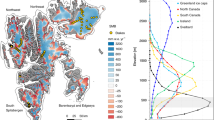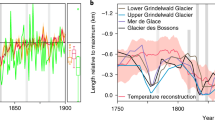Abstract
AN instantaneous glaciation model for the formation of the large Pleistocene ice sheets has been proposed by Flohn1 and by Ives et al2. It depends on the sudden buildup of a permanent snow cover over sub-Arctic upland plateaux including Baffin Island, Ungava, Labrador and Keewatin, Melville Peninsula, and the Finnmark Plateau and upland Sweden. The crucial event in this sudden snow buildup is the survival of snow over a large area for a single summer which then results in a series of feedback reactions leading to the establishment of permanent snowfields and, subsequently, icefields. I suggest here that such a survival could have resulted from one or several closely spaced massive volcanic ash eruptions.
This is a preview of subscription content, access via your institution
Access options
Subscribe to this journal
Receive 51 print issues and online access
$199.00 per year
only $3.90 per issue
Buy this article
- Purchase on Springer Link
- Instant access to full article PDF
Prices may be subject to local taxes which are calculated during checkout
Similar content being viewed by others
References
Flohn, H., Quat. Res., 4, 385–404 (1974).
Ives, J. D., Andrews, J. T., and Barry, R. G., Naturwissenschaften, 62, 118–125 (1974).
Barry, R. G., Andrews, J. T., and Mahaffy, M. A., Science, 190, 979–981 (1975).
Dyer, A. J., and Hicks, B. B., Nature, 208, 131–133 (1965).
Lamb, H. H., Palaeogeogr. Paleoclimatol. Palaeoecol., 10, 203–230 (1971).
Lamb, H. H., Proc. R. Soc., A 266, 425–533 (1970).
Bray, J. R., Adv. ecol. Res., 7, 177–233 (1971).
Arakawa, H., Pap. Meteorol, Geophys., 6, 101–115 (1955).
Rosinski, J., and Pierrard, J. M., J. atmos. terr. Physics, 24, 1017–1030 (1962).
Schell, I. I., Tufts meteorol. Stud., 58–1 (1958).
Bray, J. R., Nature, 248, 42–43 (1974).
Eaton, G. R., et al., Science, 188, 787–796 (1975).
Lamb, H. H., and Johnson, A. I., Geogr. Annlr., 41, 94–134 (1959).
Lamb, H. H., Climate: Present, Past and Future (Methuen, London, 1972).
Andrews, J. T., Davis, P. T., and Wright, C., Ice, 47, 5 (1975).
Bassett, I. R., and Terasmae, J., Can. J. Bot., 40, 141–150 (1962).
Bray, J. R., Nature, 252, 679–680 (1974).
Adam, D. P., Interim. res. Rep., No. 15, Department of Geochronology, University of Arizona, Tuscon (1969); I. N. Q. U. A. Abs., 1, (INQUA Christchurch, New Zealand, December, 1973).
Kennett, J. P., and Thunell, R. C., Science, 187, 497–503 (1975).
Stewart, R. J., Nature, 258, 505–506 (1975).
Author information
Authors and Affiliations
Rights and permissions
About this article
Cite this article
BRAY, J. Volcanic triggering of glaciation. Nature 260, 414–415 (1976). https://doi.org/10.1038/260414a0
Received:
Accepted:
Issue Date:
DOI: https://doi.org/10.1038/260414a0
This article is cited by
-
Effect of glacier loading/deloading on volcanism: postglacial volcanic production rate of the Dyngjufj�ll area, central Iceland
Bulletin of Volcanology (1992)
-
Palaeomagnetism of beach ridges in South Australia and the Milankovitch theory of ice ages
Nature (1980)
-
Neogene explosive volcanicity, temperature and glaciation
Nature (1979)
-
Volcanic triggering of glaciation
Nature (1976)
-
Volcanic triggering of glaciation (reply)
Nature (1976)
Comments
By submitting a comment you agree to abide by our Terms and Community Guidelines. If you find something abusive or that does not comply with our terms or guidelines please flag it as inappropriate.



